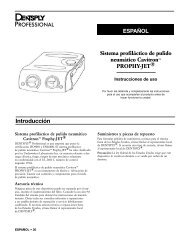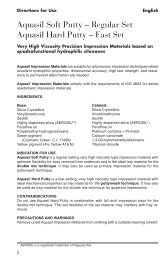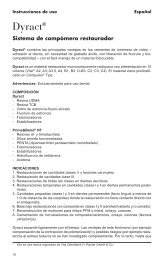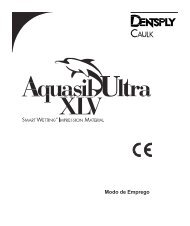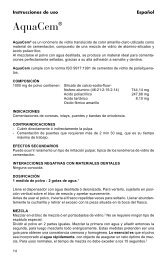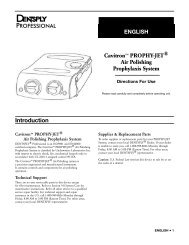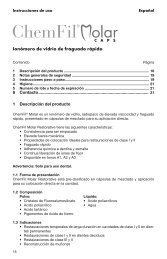Nano ceramic restorative - Dentsply
Nano ceramic restorative - Dentsply
Nano ceramic restorative - Dentsply
You also want an ePaper? Increase the reach of your titles
YUMPU automatically turns print PDFs into web optimized ePapers that Google loves.
TMnano <strong>ceramic</strong> <strong>restorative</strong>2003-08-28(For Individual Attention Only)With the compliments of<strong>Dentsply</strong> DeTrey GmbHClinical ResearchDe-Trey-Str.1D-78467 KonstanzPhone +49-7531-583-0Fax +49-7531-583-104SCIENTIFIC COMPENDIUM
Table of contents1 Introduction .................................................................................................. 32 Composite Technology................................................................................ 32.1 Traditional Composites ......................................................................................... 42.2 <strong>Nano</strong>-Ceramic Technology.................................................................................... 63 Material properties ....................................................................................... 83.1 Biocompatibility..................................................................................................... 93.1.1 Cytotoxicity ............................................................................................................................. 93.2 Mechanical strength ............................................................................................ 103.3 In-vitro simulations.............................................................................................. 143.3.1 Leinfelder Wear..................................................................................................................... 143.3.2 Marginal integrity class V .................................................................................................... 153.3.3 Marginal integrity class II.....................................................................................................163.3.4 CEBL – Simulating recutting and rebonding of composite ............................................. 183.4 Handling Properties............................................................................................. 183.4.1 Working Time........................................................................................................................ 183.4.2 Stickiness.............................................................................................................................. 193.5 Polishability.......................................................................................................... 203.6 Fluorescence........................................................................................................ 213.7 Radiopacity .......................................................................................................... 223.8 Optical Properties................................................................................................ 234 The Shade System ..................................................................................... 265 Clinical Investigations and Handling Evaluations................................... 275.1 Clinical Investigation of Class I and II restorations at University of Freiburg,Germany ............................................................................................................... 275.2 Clinical Investigation of Class V restorations at University of Bologna, Italy. 285.3 Field Monitoring Study, Germany....................................................................... 285.4 Handling Evaluation ............................................................................................ 296 Directions for Use ...................................................................................... 316.1 COMPOSITION ..................................................................................................... 316.2 INDICATIONS FOR USE....................................................................................... 326.3 CONTRAINDICATIONS......................................................................................... 326.4 WARNINGS........................................................................................................... 326.5 PRECAUTIONS..................................................................................................... 326.6 ADVERSE REACTIONS........................................................................................ 336.7 INTERACTIONS WITH OTHER DENTAL MATERIALS ........................................ 336.8 STEP-BY-STEP INSTRUCTIONS ......................................................................... 336.9 STORAGE ............................................................................................................. 377 References.................................................................................................. 388 List of Figures and Tables......................................................................... 392
1 IntroductionDENTSPLY DeTrey develops advanced technologies for superior dental materials. Abreakthrough was achieved by applying <strong>Nano</strong>-Ceramic Technology to develop our newUniversal <strong>Nano</strong>-Ceramic Restorative Ceram•X.Ceram•X is a light curable, radiopaque <strong>restorative</strong> material for anterior and posteriorrestorations of primary and permanent teeth. Based on proprietory <strong>Nano</strong>-CeramicTechnology, Ceram•X offers natural aesthetics achieved by an easy procedure, superiorhandling characteristics and excellent durability.Ceram•X is available in two distinct shading systems:Ceram•X mono, the Single Translucency System, comprises seven shades of intermediatetranslucency comparable to conventional composites (e.g. Spectrum ® TPH), optimal for fastand easy restorations of posterior or anterior teeth.Ceram•X duo, the Double Translucency System, offers four dentin shades withtranslucencies similar to natural dentin and three enamel shades which mimic naturalenamel. Their design has been optimized for advanced aesthetic restorations achievablewith a minimum number of shades. For the enamel shades, the <strong>Nano</strong>-Ceramic Technologycreates an ideal balance between handling and optical characteristics.2 Composite TechnologyModern light curable resin based <strong>restorative</strong>s may be classified according to the chemistry ofthe resins:In this context dental composites are understood as materials comprising curabledimethacrylic resins based on hydrocarbon molecular structures (e.g. Bis-GMA, TGDMA,UDMA) and methacrylate functionalised but otherwise non-reactive fillers. Setting occurs dueto radical polymerisation of the resins. Compomers as another important subgroup of dental<strong>restorative</strong>s comprise methacrylate functionalised reactive fillers and polyacid modifiedmethacrylate resins which promote (after post-cure controlled water up-take) an additionalionomer setting reaction accompanied by fluoride release.3
2.1 Traditional CompositesTraditionally, dental composites are classified according to their filler particle size distributioninto subgroups of hybrid, micro-hybrid and microfilled composites:• Microfilled Composites comprise only microfillers with an average agglomerate size(d 50 ) of < 0.4 µm. To increase filler load, microfilled composites contain also prepolymerisedmicrofilled resin (Figure 1).• To further increase filler load and mechanical strength, Hybrid Compositescomprise besides the agglomerates known from microfillers solid glass fillers insteadof the prepolymerized resin particles. These glass fillers are of an average particlesize (d 50 ) of about 1 – 10 µm (Figure 2).• Recent developments lead to smaller sizes of the glass filler fraction with an averageparticle size (d 50 ) of about 0.4 – 1 µm resulting in the so calledMicro-Hybrid Composites (Figure 3).ResinMicrofiller:Aggregates of <strong>Nano</strong>sized ParticlesPrepolymerizedResin withMicrofiller< 0.4 µmFigure 1Schematic illustration of a microfilled composite.4
Microfiller < 0.4 µmResinGlass filler: ~1-10 µmFigure 2Schematic illustration of a hybrid composite.Microfiller < 0.4 µmResinGlass filler:~ 0.4 - 1 µmFigure 3Schematic illustration of a micro-hybrid compositeIn general, high filler loads support mechanical strength and reduce polymerisationshrinkage. Larger filler particles facilitate high filler loads due to their lower specific surfacearea and the corresponding lower energy to wet these particles with resin. On the other handsmaller particles are favourable to obtain superior aesthetics, polishability and wearresistance. However, smaller particles, i.e. sub-micron particles are more difficult to wet andare therefore often agglomerated and hence partially off-setting the desired effects.Typically, primary particles in the size of ≤ 50 nm are not homogeneously dispersed butaggregate strongly to form large three-dimensional agglomerates of several 100 nmdiameter up to ca. 0.4 µm (400 nm) (Figure 1).The homogeneous dispersion and complete resin wetting of nano-sized filler particles isdesired to improve the aesthetic and mechanical properties of composites and is the subjectof <strong>Nano</strong>-Technology developments.5
2.2 <strong>Nano</strong>-Ceramic TechnologyIn 1997 DENTSPLY applied <strong>Nano</strong>-Technology for the first time in dentistry introducing theinnovative adhesive Prime&Bond ® NT which is reinforced with highly dispersed and nonaggregatednanofillers.Based on the long experience DENTSPLY gained in the field of nano-technology Ceram•Xcomprises Organically Modified Ceramic nano-particles and <strong>Nano</strong>fillers as used inPrime&Bond NT combined with conventional glass fillers of ~1 µm (Figure 4).Ceram•X merges hybrid composite filler technology with advanced <strong>Nano</strong>-Technology. Thisresults in <strong>Nano</strong>-Ceramic Technology.<strong>Nano</strong>-Ceramic Particles& <strong>Nano</strong>fillerGlass filler~ 1 µmResinFigure 4Schematic illustration of Ceram•X.The Ceram•X nano-particles are highly dispersed due to an innovative manufacturingprocess: Starting from silane precursors the Organically Modified Ceramic nano-particles areachieved via controlled hydrolysis and condensation reactions (Figure 5).6
OOOSiRprecursorOOcondensingreactionOOOOOOSi OOOSiOSiOOOOSiO OO SiO OOSiOOOOOOOOOO Si SiOOOOSiO O O SiO SiO O O OO SiOSiOOOOOSiOOOOFigure 5Processing of Organically Modified Ceramic nano-particles.The Organically Modified Ceramic nano-particles comprise a polysiloxane backbone. Thechemical nature of the siloxane backbone is similar to that of glass and <strong>ceramic</strong>s. Thedegree of condensation was investigated by 29 Si-NMR-analasys. Figure 6 shows that thebackbone is highly condensed.perfect, highly condensed siloxanelower degree ofcondensation1251007550250-25-50-75-100-125-150-175Figure 629 Si-NMR-analasys (Mayer, 2003)Methacrylic groups are attached to the backbone via silicon-carbon-bonds. These <strong>Nano</strong>-Ceramic particles can be best described as inorganic-organic hybrid particles where theinorganic siloxane part provides strength and the organic methacrylic part makes theparticles compatible and polymerisable with the resin matrix.The structure of the <strong>Nano</strong>-Ceramic particles is similiar to the methacrylic modified <strong>Nano</strong>fillersas used in Prime&Bond NT (Figure 7).7
<strong>Nano</strong> Particle & <strong>Nano</strong>fillerOOOOOOOSi O O O O Si SiOOOOOOSiO SiO O O SiO O O SiSiO O O O OSiOOOO SiOO O Si OOOO SiO O OOOSiOOSiOOOOOOOOOOSiOOOSiOOOSiOSiSiOO OSi OOOSiSiOO OO SiOO O SiSiSi SiO OOOOSi OSiO O SiOOOOOOSame type as usedin Prime&Bond NTOOOOOOFigure 7Schematic structures of <strong>Nano</strong>-Ceramic particles and nanofillers.The size of the <strong>Nano</strong>-Ceramic particles was investigated by X-ray diffraction and was foundto be ~2.3 nm (Figure 8).c.p.s [a.u.]~ 2.3 nm ~ 10 nm0 2.5 5 7.5 10 12.5 15 scattering angle [°]Figure 8X-ray diffraction to determine the size of nano-particles(Lattermann, 2003)Beside dentistry Organically Modified Ceramics are used in a variety of industrial or technicalapplications for instance in coatings with superior scratch resistance or corrosion protection.3 Material properties<strong>Nano</strong>-<strong>ceramic</strong> technology as applied in Ceram•X offers several advantages, such as highbiocompatibility (chapter 3.1), high fracture toughness (chapter 3.2), and allows to use a newstabilizer resulting in excellent working time under ambient light (chapter 3.4.1).The following chapters describe investigations performed to characterize Ceram•X in furtherdetails and in comparison to other currently used <strong>restorative</strong>s.8
3.1 BiocompatibilityDue to the presence of the <strong>Nano</strong>-Ceramic particles the content of conventional resins inCeram•X could be reduced significantly without compromising handling properties (seeChapter 5.4).Besides standard investigations to confirm the safety of the used components in regard totoxicity, internal HPLC measurements confirmed that the reduced amount and kind of resinsused in the formulation lead to a reduced post-curing monomer leakage.Based on this reduced monomer leakage Ceram•X exhibits excellent biocompatibility asshown by cytotoxicity investigations.3.1.1 CytotoxicityTo test cytotoxicity samples of cured material are immersed in cell cultures (mousefibroblasts L-929). After incubation the number of cells is counted and compared to thenegative control (glass) which is assumed to have no adverse effect to the proliferation ofthe cells during incubation.The relative cell number expresses the degree of cytotoxicity. Cells incubated together withfreshly cured Ceram•X show significant higher proliferation than competitive materials and istherefore significant less cytotoxic (Figure 9).L 929-Proliferation (relative cell growth)number of cells [%]100806040200Ceram•X Tetric Ceram Ketac Molar Durelonpos. controlFigure 9Initial Cytotoxicity by means of relative cell growth of various dental materials(Schedle, 2003)In two additional experiments samples have been aged in the used incubation mediabeforehand for 7 days and 6 weeks, respectively. All materials under investigation showedlower cytotoxic effect. This suggests that cytotoxicity depends on the leakage pattern ofrelevant substances. Once, these are leaked out cytotoxicity drops.9
In Ceram•X conventional resins are replaced by nano-<strong>ceramic</strong> particles to a great extendresulting in a better compatibility to cells. Further investigations on inflammatory propertiesare on-going.3.2 Mechanical strengthCeram•X was measured internally regarding compressive strength and flexural strength.From these measurements yield strength (reflecting the force needed to permanently deformthe material) and E-modulus were determined as well.[MP a]450400Enamel shades350300250200150100500Ceram XTetricCeramArtemisDentinA2VenusOA2Z100 Z250 Filtek AdmiraSupremeA2BFigure 10Compressive Strength[MP a]200180160140120100806040200Ceram XTetricCeramArtemisDentinA2VenusOA2Enamel shadesZ100 Z250 Filtek AdmiraSupremeA2BFigure 11Yield Strength10
[MP a]160140Enamel shades120100806040200Ceram XTetricCeramArtemisDentinA2VenusOA2Z100 Z250 Filtek AdmiraSupremeA2BFigure 12Flexural Strength[GP a]1412108642Enamel shades0Ceram•XTetricCeramArtemisDentinA2VenusOA2Z100 Z250 Filtek AdmiraSupremeA2BFigure 13E-ModulusFracture toughness (K 1c ) reflects the resistance of a material to crack propagation. Thefracture toughness of Ceram•X is outstanding compared to competitive <strong>restorative</strong>s (Figure14) and comparable to values found for dentin (Craig, 1997).11
K Ic [MPa*m 1/2 ]32Enamel*Dentine*10Ceram•XSpectrum FiltekTPH SupremeZ250 InTenS Compo Helioglass molarFigure 14Fracture Toughness K 1C(Schultz et al, 2003; except Ceram•X: unpublished data)The good resistance to micro-crack propagation might be related to the strengthening effectof the nano-<strong>ceramic</strong> particles. Propagating cracks are either more often reflected orabsorbed by the nano-<strong>ceramic</strong> particles (Figure 15).Micro-Crack PropagationReduced Micro-Crack PropagationResinGlass fillerGlass fillerHybrid Composite<strong>Nano</strong>-Ceramic RestorativeFigure 15Schematic illustration of crack propagation in different materials12
The physical properties of Ceram•X have been summarized in Table 1. The stipulated valuesrepresent typical findings.Property Unit ISO 4049Ceram•Xmono duo D duo ECompressive strength MPa 320Yield strength MPa 130Flexural strength MPa > 80 110Flexural modulus GPa 8.5Filler 1 content (weight / volume) % 76 / 57Glass filler size (mean) µm 1.1 – 1.5<strong>Nano</strong> filler size (mean) nm 10<strong>Nano</strong> particle size (mean) nm 2.3Shrinkage (Archimedes) % (v/v) 2.3Expansion in water % (v/v) 0.5Water sorption µg/mm³ < 40 13.6Water solubility µg/mm³ < 7.5 -1.3 2Curing time 2mm 500 mW/cm²800 mW/cm²s 20 403010Sensitivity to ambient light(10.000 lx)s > 60(8.000 lx)140 170 180Measured radiopacity mm Al 2Table 1Technical data sheet Ceram•XConclusions:⇒ The mechanical properties of Ceram•X are within the range of modern <strong>restorative</strong>materials with the exception of⇒ Fracture toughness which is extraordinary high. It is expected that this will contribute toan improved durability.1 Conventional and <strong>Nano</strong>-Filler2 Negative value due to very low solubility and remaining absorbed water13
⇒ The working time of at least 140 sec contributes to the ease of handling and gives thedentist sufficient time to manipulate the material under operating light conditions.3.3 In-vitro simulationsIn-vitro simulation of the final clinical usage provides further information on the expectedclinical behavior of newly developed materials. Wear and marginal quality are among themost important investigations to predict a material’s clinical performance in-vitro.3.3.1 Leinfelder WearThe Leinfelder Wear machine allows simulating different modes of wear. For thisinvestigation masticatory stresses were transferred to a composite specimen by means of astainless steel conical stylus in the presence of a slurry of polymethylmethacrylate beads(PMMA) simulating localized wear.Surfaces of the samples are 3D profiled before and after wear to allow determination ofvolume loss and maximum depth in the wear facets (Figure 16).Volume [mm³]0,080,060,04Volume lossMaximum depth200150100Depth [µm]0,02500,00Ceram Xduo ECeram Xduo DTetricCeramCeram Xduo ECeram Xduo DTetricCeram0Figure 16Leinfelder Wear: 400.000 cycles 1Hz, 80 N load, 30° rotation(Latta, 2003)The results after a simulated wear period of ~3 years suggests that Ceram•X duo Dentin(which is besides shading identical to Ceram•X mono) compares well to the control materialand that the tested Ceram•X duo Enamel shade wears significantly less compared to both.Therefore it can be concluded that Ceram•X is suitable for all indications of a direct<strong>restorative</strong> in regard to wear.14
3.3.2 Marginal integrity class VEven though marginal integrity mainly depends on the used adhesive it is advisable to testnewly developed <strong>restorative</strong>s on marginal integrity.In this investigation restored teeth were immersed in a 0.5% water solution of basic fuchsinefor 24 hours and rinsed for 5 minutes with distilled water. After this, the specimens wereembedded in acrylic resin and bucco-lingual sections were obtained from each resinembedded specimen with a diamond saw. Microleakage was quantified separately for theocclusal and gingival walls of the class V cavities under an optical microscope. The extent ofmicroleakage (Figure 18) along the restoration was expressed in grades as listed in Table 2and shown in Figure 17.Grade Description0: Hermetic seal, no leakage1: Mild microleakage, dye infiltrating not more than half of the wall2: Moderate microleakage, dye infiltrating more than half of thewall, but does not reach axial wall.3: Massive microleakage, dye to the full extension of the wall andincluding the axial wall).Table 2 Grading of dye penetration (Rosales, 2003)Class V Cavities32PermeabilityOcclusal Wall = Enamel1Micro-LeakageGingival Wall = Dentine0Microleakage grades:0: hermetic seal1: mild2: moderate3: massiveDentin permeability:0: negative,dentin tubules sealed1: positive,absence of dentintubules sealing.Figure 17 Legend for grades of microleakage and dentin permeability (Rosales, 2003)15
Leakage [%]100806040200enameldentin3210enameldentin21010enameldentin2100enameldentin321010enameldentin3210a dSyntacclassicTetricCeramabP&B NTCeramXduob bXeno IIICeramXduoa cOptib.Solo +CeramXduob di-BondCeramXduoFigure 18Grades of Microleakage (0 to 3) and statistical grouping (a to d) (Rosales,2003)Restorations with Ceram•X either in combination with Prime&Bond NT or Xeno ® III showedoverall less marginal leakage compared to the control groups.Infiltration [% ]1009080706050403020100a bSyntacclassicTetricCerama bP&B NTCeramXduoa aXeno IIICeramXduoa bOptib.Solo +CeramXduoa ai-BondCeramXduosealednot sealedFigure 19 Dentin permeability (yes / no) and statistical grouping (a, b) (Rosales, 2003)As Figure 19 shows dentine treated with self-etch adhesives did not show permeabilitydespite the microleakage that was found (compare to Figure 18).3.3.3 Marginal integrity class IIIn this investigation a chewing simulator was used to age the samples. Freshly extractedhuman molars where used to prepare class II cavities with one approximal box limited toenamel and the other being extended into dentin. The incremental filling technique used isdescribed in Figure 20.16
Box in enamelBox in dentineOcclusal partFigure 20 Incremental filling technique used for class II (Manhart, 1999)After stressing the restorations by 2.000 thermo cycles between 5 and 55°C and50.000 chewing actions with a load of 50N replicas were produced and approximal cavosurface margins were investigated under SEM by 200 magnifications. Percentage of perfectmargins, gap (>1µm), swelling, and sites that can not be judged were recorded. Results ofthe present investigation and a former investigation under the same operator and the sameexperimental conditions are summarized in Figure 21.P erfect Margins [% ]10080604020Enamel boxDentin boxCeram•X +Xeno IIICeram•X +P&B NTTetric Ceram +Syntac Classic0EnamelEnamelDentinFigure 21Distribution of perfect margins after aging in a chewing simulator(Ceram•X: Manhart, 2003; Tetric Ceram: Manhart, 2002)Conclusions⇒ Ceram•X in combination with either Prime&Bond NT or Xeno III offers marginal integritysimilar or better to the control groups17
3.3.4 CEBL – Simulating recutting and rebonding of compositeThe final aspect of aesthetic restorations depends among others on the correct layering ifdifferent transparencies are used. Especially at the beginning of the learning curve whenusing a new material it may occur that the correct thickness of layers are not met. Instead ofvirtually building up the total restoration beforehand in order to know the correct thickness ofeach layer the CEBL-technique - Cut-Back, Etch, Bond, Layer – suggests to cut back curedcomposite either by purpose or in case layering was too thick, to etch and apply a bondingbefore finally placing the next layer (Blank, 2003).First results are shown in Figure 22 where the positive control is layering composite withoutany treatment in between the layers and the test group comprises grinding with 320 grit,etching using phosphoric acid for 15 seconds, applying Prime&Bond NT as adhesive andfinally placing the composite.Cut-back, Etch, Bond, Layeringbond strenght [MPa]403020100PosNTE3/D2CEBLNTE3/D2Figure 22 Bond Strength after CEBL technique (Latta, 2003)Conclusions⇒ The results suggests that immediate rebonding of Ceram•X during the placement of arestoration does not adversely affect the bond strength between each layer.3.4 Handling Properties3.4.1 Working TimeCeram•X comprises an innovative non-leachable proprietary inhibitor system (Figure 23).The Working time is up to 180 sec (at 10.000 Lux) even in the case of highly translucent18
enamel shades. This extended working time provides handling convenience. Thenon-leachable inhibitor molecule is polymerized into the network. Therefore it does not leachout and contributes to the excellent biocompatibility as described in chapter 3.1.S*OFigure 23Schematic illustration of the new non-leachable inhibitorThe resulting working time for Ceram•X mono and Ceram•X duo Enamel and Dentine iscompared to a variety of <strong>restorative</strong>s in Figure 24.Sensitivity to ambient light (10.000 Lux)Time [s]300240180120600monoduo Enamelduo DentinCeram•XA2BodyA2EnamelFiltekSupreme2 minutesA2A2O A2A2Z250 Z100 VenusA2TetricCeramDentin A2Enamel A2ArtemisFigure 24Working time of different <strong>restorative</strong>s and transparencies.3.4.2 StickinessPaste handling is a very important factor not only for the convenience during restoration butfor the long-term results as well. Placing sticky pastes into cavities and retracting theinstrument may produce voids to the adhesive or previous composite layer even beforecuring. The assessment of paste handling could be done until now either by indirectmeasurements like determination of consistency or by trained evaluators.In this study a recently published method (Al-Sharaa et al, 2003) was used to determine thestickiness for a variety of materials – including enamel shades where available. By placing ametal instrument onto the material and retracting it afterwards, material is torn upwards untilthe adhesion to the instrument is lower than the intrinsic cohesion of the material. The19
pattern of resin (Figure 25) is than cured and measured for mean height (Figure 26) andsurface area.Figure 25 Plot to determine height of the resin pattern (Watts et al, 2003)Height [mm]1.61.20.80.423° C37°C0Ceram•XmonoTetricCeramZ250QuiXfilCeram•Xduo E3ArtemisA2EnamelVenus A2(Enamel)FiltekSupr. BFiltekSupr. EFigure 26 Stickiness to metal instruments (Watts et al, 2003)Conclusions⇒ This study supports the finding from an extended seeding trial in which course 1325restorations were performed and dentists rated reduced stickiness to metal instrumentsas the most important advantage in handling for Ceram•X.3.5 PolishabilitySuperior aesthetic restorations are one of the most demanding indications for dentists.Besides matching shade (see also chapter 4) and contour of the natural tooth, surfacemorphology of the final restoration is very important to achieve a highly aesthetic result.20
In this investigation surface quality after polishing following different protocols (Table 3) wasmeasured by means of the medium roughness R a (Figure 27).SofLexEnhanceClinical situation Approximal surfaces Occlusal surfacesStep 1 Coarse disc Diamond bur : 30 µm5 strokes 5 strokesStep 2 Medium disc Enhance disc5 strokes until grooves removingStep 3 Fine disc Prisma gloss regular10 strokes 20 sStep 4 Super fine disc Prisma gloss extrafine10 strokes 20 sTable 3 Protocols for polishing of different clinical situations (Salomon, 2003)Ra Value [µm]0,160,120,08gSof-Lex XTapprox.Enhanceoccl.0,040,00CeramXduoE3ArtemisEnamelA2TetricCeramVenusA2(E)Z100Z250FiltekSupremeA2EFigure 27Surface Roughness after simulated polishing procedures for approximal andocclusal surfaces (Salomon, 2003)Conclusions⇒ Using the Enhance Polishing system for Ceram•X results in very low surface roughnessand high gloss, respectively.3.6 FluorescenceFigure 28 shows that Ceram•X provides sufficient fluorescence whereas other <strong>restorative</strong>sshow a lack of fluorescence. Non-fluorescent restorations exposed to so called black lightwill be prone to de-masking effects indicating missing tooth substance.21
Z100 Z 250FiltekSupremeA2BFiltekSupremeA2ECeram Xduo E1Ceram Xduo E3Ceram Xduo D2TetricCeramArtemisA2DArtemisA2EVenusOA2Figure 28Fluorescence to light of 254 nm wavelength3.7 RadiopacityBesides measurement of radiopacity of Ceram•X (2 mm Al) a radiograph was taken tooptically compare among various <strong>restorative</strong>s (Figure 29).TetricCeramArtemisA2DArtemisA2EVenusOA2Ceram Xduo E1Ceram Xduo E3Ceram Xduo D2Z100 Z 250FiltekSupremeA2BFiltekSupremeA2EFigure 29Radiograph of 2mm thick samples to compare radiopacity22
Conclusions⇒ Ceram•X offers a well balanced radiopacity and can easily be detected on radiographs.3.8 Optical PropertiesCeram•X is offered in two distinguished systems: Ceram•X mono as universal singletranslucency system and Ceram•X duo as easy to use double translucency system to rebuildteeth naturally.Only 3 enamel shades and 4 dentine shades of Ceram•X duo are sufficient to cover thewhole VITA range. This is possible due to the precise tuning of chroma and opacity withinthese 7 shades. (An additional shade (DB) is available to restore bleached teeth.)Measurements are based on the CIE – L*a*b* system and calculations are done accordingto DIN 5033, part 3 and DIN 6174.In Figure 30 opacity 3 of all Ceram•X duo enamel and dentine shades are shown. The opacityof various materials that are referred to as VITA A2 are shown in Figure 31. Ceram•X monofalls well into the opacity of other materials available in one translucency, only. On the otherhand, it is noticeable that Ceram•X is from the products shown in Figure 31 the only doubletranslucency system 4 offering a difference in opacity between enamel and dentin shades thatreflects the difference in opacity of human enamel to dentin.6050403020100E1 E2 E3 DB D1 D2 D3 D4Figure 30Opacity of Ceram•X duo shades3 Y-value black background / Y-value white background in percentage4 In other systems 3 or more translucencies are necessary to cover this spread in opacity.23
Opacity [%]605040302010E2D2EnamelBodyEnamelDentinA2O-A20Ceram•XmonoM2TetricCeramA2Z100A2Z250A2Ceram•XduoFiltekSupremeA2ArtemisA2VenusFigure 31Opacity of single and double translucency <strong>restorative</strong> materialsThe Chroma 5 C* (which reflects the saturation of the colour) is shown in Figure 32. Note theeven distribution among shades.(C* (CIE)35302520151050E1 E2 E3 DB D1 D2 D3 D4Figure 32Chroma C* of Ceram•XIt can be seen that the Ceram•X duo system is systematically designed which is reflected inthe overall difference (ΔE) between the shades as well (Figure 33) and makes it easier tolearn and understand the shading concept during daily treatment in practice.5 C* = √(a*² + b*²)24
delta E vs. E1Ceram•X duo Enamel Shades9630E1 E2 E3delta E vs. D120151050Ceram•X duo Dentin ShadesD1 D2 D3 D4Figure 33ΔE values for enamel and dentin shadesYounger teeth are more opaque, lighter and show less chroma compared to older teethwhich show higher chroma in dentin and less opacity in enamel.This is reflected in the Ceram•X duo system where shades with higher chroma have lessvalue and opacity (Figure 34).valuechromatranslucencyE1 E2 E3valuechromatranslucencyDBbleachD1 D2 D3 D4Figure 34Schematic overview on properties influencing the final shade of a restorationConclusion⇒ The shading concept of Ceram•X duo is systematically designed and reflects shadebehavior of natural dentition. Therefore, it supports the dentist in achieving aestheticalrestorations.25
4 The Shade SystemCeram•X was designed to cover all aesthetic and practical demands in restoring naturaltooth colours. The developmental goal was to provide an easy shading system for advancedaesthetic solutions as well as for fast restorations on a primary level. Thus, two separateshading concepts have been integrated in one product. Ceram•X is based on the colours ofnatural tooth substance, nevertheless both systems offer reference to the established Vita ®system.With the Ceram•X mono shades M1 to M7, Ceram•X comprises seven colours ofintermediate translucency (similar to e.g. Spectrum ® TPH or Dyract ® eXtra) for therestoration of the complete defect. The Ceram•X mono concept is ideal for fast and easyanterior and posterior restorations. In order to ensure coverage of the entire VitapanClassical shade range, each of the seven Ceram•X mono shades fits for several Vita shadessimilar in colour and lightness.For aesthetically demanding cases, the Ceram•X duo system offers four dentin (duo D1 toduo D4) and three enamel colours (duo E1 to duo E3). Their colour values andtranslucencies are on a level similar to those of natural tooth substance. In their variouscombinations, the seven Ceram•X duo dentins and enamels enable the dental professionalto benefit from a superior optical results. Additionally, one bleach dentin colour (duo DB) isavailable for restoration of bleached teeth.Along with the packages comes a self-sticky recipe label (Figure 35), ideal for fixation on therear side of the Vita Shade guide, providing a quick survey over the Vita dedicated Ceram•Xshades in both mono and duo technique.Figure 35i-shade label for Vita reference of Ceram•X mono and duoThe Ceram•X mono and Ceram•X duo systems are available separately.26
5 Clinical Investigations and Handling EvaluationsDespite of the significance of in-vitro investigations, conducted both internally and externally,clinical investigations provide final certainty concerning the efficacy of new <strong>restorative</strong>technologies. Therefore, several investigations on different cavity classes have been startedand results have yet been obtained. In all studies, Ceram•X mono has been applied incombination with an experimental total etch adhesive (DENTSPLY code: K-0127).5.1 Clinical Investigation of Class I and II restorations at University ofFreiburg, GermanyBeing one of the major indications of <strong>restorative</strong>s materials, the clinical behaviour ofmaterials in class I and II cavities is of particular interest. Accordingly, a controlledlongitudinal class I and II investigation is conducted at the Department of OperativeDentistry, Albert-Ludwigs-University of Freiburg, Germany (Head: Professor Dr. E. Hellwig).Under guidance of Main Investigator Priv.-Doz. Dr. P. Hahn, Associate Professor, 43Ceram•X restorations and 43 controls (Tetric ® Ceram/ Syntac ® Classic) have beenestablished in a corresponding number of patients. The 6-month results on 38 patients areprovided in Table 4.Restorative Ceram•X [%] Tetric [%]Parameter alpha bravo charlie delta alpha bravoRetention 100 0 0 0 100 0Marginal Integrity 94.7 5.3 0 0 92.1 7.9Marginal Discolouration 94.7 5.3 0 0 94.7 5.3Post-op Sensitivity 97.4 2.6 0 0 100 0Secondary Caries 100 0 0 0 100 0Colour Match 97.4 2.6 0 0 100 0Anatomical Form 100 0 0 0 97.4 2.6Surface texture 100 0 0 0 100 0Table 4 6 month results in class I and II (Hahn, 2003)The investigation is designed according to revised ADA (American Dental Association)guidelines for composite resin materials for posterior restorations. Ryge criteria are applied.27
5.2 Clinical Investigation of Class V restorations at University of Bologna,ItalyAs adhesion still remains one of the potential weaknesses of <strong>restorative</strong> therapy, data onclinical success of class V’s is essential. Thus, Professor Dr. G. Dondi dall’Orologio, Head ofDepartment of Operative Dentistry at University of Bologna, Italy, is conducting a longitudinalclinical investigation on restoration of caries free cervical lesions. 100 restorations have beenestablished in 50 patients. The 6 month results in all 50 patients are provided in Table 5.Restorative Ceram•X [%]Parameter alpha bravo charlie deltaRetention 100 0 0 0Marginal Integrity 100 0 0 0Marginal Discolouration 100 0 0 0Post-op Sensitivity 100 0 0 0Secondary Caries 100 0 0 0Colour Match 100 0 0 0Anatomical Form 100 0 0 0Table 5 6 month results class V (Dondi dall'Orologio, 2003)The investigation is designed according to revised ADA (American Dental Association)guidelines for dentin and enamel adhesive materials. Ryge criteria are applied.5.3 Field Monitoring Study, GermanyIn this recently introduced study concept, Ceram•X Class V restorations established underconditions of private practice are investigated. 22 private practitioners placed up to 10Ceram•X mono restorations each in patients of their practices. No special recallappointments are agreed, instead evaluation of restorations is conducted in connection withroutine visits of patients.Placement phase has been closed in February 2003, 188 restorations have beenestablished. The clinical information available up to now concerns 88 restorations in totalrespectively 49 restorations monitored after at least 83 days (92 days - 10% = 3 monthresults). One retention failure has been reported. Information on change in parameters28
“marginal discolouration”, “marginal crevice” and “secondary caries” is only available whennecessitating the change of restoration. The results for 88 restorations are given in Table 6.Change Yes no totalParameter [%] [n] [%] [n] [n]Retention 98.9 87 1.1 1 88Marginal Crevice 0 0 100 87 87Marginal Discolouration 0 0 100 87 87Post-op Sensitivity 3.4 3 96.6 84 87Secondary Caries 0 0 100 48 87Replacement needed 0 0 100 48 87Table 6 Results of the Field Study (Schaller, 2003)This study is conducted under scientific guidance of Prof. Dr. H.-G. Schaller, Martin-Luther-University of Halle-Wittenberg, Germany.Conclusion⇒ Based on the results of the clinical studies, it can be concluded that for the consideredinterval neither safety nor efficacy problems were observed for Ceram•X.5.4 Handling EvaluationIn context with the Field Study, handling properties of Ceram•X were rated by theparticipating practitioners. Stickiness, consistency, sculptability, polishability, marginaladaptability and processing time were rated in comparison to the <strong>restorative</strong> standardproduct currently used in the respective practice. For all those criteria, a clear majority ofpractitioners rated Ceram•X equal or better than the standard. The results are provided inFigure 36. The overall rating of handling properties is shown in Figure 37.29
dentists [% ]10080604020significantlyworseworseequalbettersignificantlybetter0Consistency PolishabilityStickiness SculptabilityMarginalAdaptabilityProcessingtimeFigure 36Rating of handling properties of Ceram•X compared to standard <strong>restorative</strong>productNumber of dentists1412108642010 1010 0very good good mediocre bad very badFigure 37Overall rating of handling propertiesIn context with the Clinical Investigation of Class V restorations, a handling blind test wasalso conducted by the investigators of the University of Bologna concerning stickiness,slumping, layering and polishability of the material. For each investigator, a sum score wascalculated. As a result, Ceram•X was rated equal or superior to the reference materials Z100and Tetric Ceram.Conclusion⇒ From both handling evaluations, conducted in context with the field study and the clinicaltrial at University of Bologna, it can be concluded that the material shows very goodhandling properties. Ceram•X convinced the practitioners working with the material.30
6 Directions for UseCeram•X UNIVERSAL NANO-CERAMIC RESTORATIVECeram•X is a light cured, radiopaque <strong>restorative</strong> material for restoration of anterior andposterior teeth. Ceram•X combines <strong>Nano</strong>technology, proprietary to DENTSPLY and knownfrom Prime&Bond ® NT, with improved organically modified Ceramic particles, resulting in a<strong>Nano</strong>-Ceramic Restorative with unique features. Thus, Ceram•X offers natural aestheticsby simple procedure, extraordinary low monomer release and superior handlingcharacteristics.Ceram•X provides the convenient Natural-Shade system: two shading systems in oneproduct cover all clinical and aesthetic demands for anterior and posterior teeth.Ceram•X o o, the Single Translucency System, comprises seven shades of intermediatetranslucency comparable to conventional composites (e.g. Spectrum ® TPH), optimal for fastand easy restorations of posterior or anterior teeth.Ceram•X duo, the Double Translucency System, offers four dentin shades withtranslucencies of natural dentin and three enamel shades which mimic natural enamel. Theirdesign has been optimized for highly aesthetic restorations with a minimum number ofshades. For the enamel shades, the unique <strong>Nano</strong>-Ceramic matrix in combination with theoptimized filler particle size distribution create an ideal balance between handling and opticalcharacteristics. Additionally, Ceram•X d o comprises one bleach dentine shade for therestoration of bleached teeth.The Ceram•X i-shade label eases shade selection, covering the whole Vita ®6 classicalshade range for both the Ceram•X o o and the Ceram•X d o system.Ceram•X is to be used with either total-etch nano-technology dental adhesive Prime&BondNT or the single-step self-etching adhesive Xeno ® III.The Ceram•X <strong>restorative</strong> system is available in predosed Compules ® -Tips and Easy-Twistsyringes.Caution: For dental use only.6.1 COMPOSITIONmethacrylate modified polysiloxane 7dimethacrylate resinfluorescence pigmentUV stabilizer6 Vita is a registered trademark of Vita Zahnfabrik H. Rauter GmbH & Co. KG, Bad Säckingen, Germany.7 organically modified <strong>ceramic</strong>31
stabilizercamphorquinoneethyl-4(dimethylamino)benzoatebarium-aluminium-borosilicate glassmethacrylate functionalised silicon dioxide nano filleriron oxide pigments and titanium oxide pigments and aluminium sulfo silicate pigmentsaccording to shade6.2 INDICATIONS FOR USEDirect restorations of all cavity classes in anterior and posterior teeth.6.3 CONTRAINDICATIONSKnown allergy to methacrylate resins or any other of the components.6.4 WARNINGS- Ceram•X contains methacrylates which may be irritating to skin and eyes. In case ofcontact with eyes, rinse immediately with plenty of water and seek medical advice. Aftercontact with skin, wash immediately with plenty of soap and water. Do not take internally.- Ceram•X contains polymerizable monomers which may cause skin sensitization (allergiccontact dermatitis) in susceptible persons. Wash thoroughly with soap and water aftercontact. If skin sensitization occurs, or if a known allergy to methacrylate resin exists,discontinue use.6.5 PRECAUTIONSWhen using Ceram•X Compules tips, use a gentle, even motion when exerting pressure onthe applicator gun. Use of excessive force or sudden movement could create a potentialhazard with extrusion.32
6.6 ADVERSE REACTIONS- The following adverse reaction has been associated with the use of polymerisablemonomers:- Skin sensitization (allergic contact dermatitis).6.7 INTERACTIONS WITH OTHER DENTAL MATERIALSEugenol and hydrogen peroxide containing dental materials should not be used inconjunction with these products because they may prevent setting and cause softening ofthe polymeric components of the material.6.8 STEP-BY-STEP INSTRUCTIONSShade Selection- The Ceram•X <strong>Nano</strong>-Ceramic Restorative comprises two separate shading systems:- Ceram•X o o, the Single Translucency System with seven shades for clinical standardsituations (Mono M1, M2, M3, M4, M5, M6 and M7)- and- Ceram•X duo, the Double Translucency System with four dentin shades (Duo D1, D2, D3and D4) and three enamel shades (Duo E1, E2 and E3) for aesthetically demandingcases. Within Ceram•X d o, one bleach dentin shade (Duo DB) is available for therestoration of bleached teeth.A) Shade selection using the Vitapan ®8 classical shade guideThe Ceram•X shades can be attributed to the Vitapan classical shade guide. Thus, it ispossible to select the tooth colour to be restored from a Vitapan classical shade guide forboth the Ceram•X mono and the Ceram•X duo system:Ceram•X o o (Single Translucency System)Refer to the central regions of the natural tooth and the Vita shade fingers. Chose the Vitashade most closely matching the tooth colour.Seven Ceram•X o o shades of intermediate translucency are available for restorations inSingle Translucency Technique. Each Ceram•X o o shade is suitable for several similarVita shades. Having determined the tooth colour by means of a Vitapan classical shadeguide, select the corresponding Ceram•X o o shade from the below table:8 Vitapan is a registered trademark of Vita Zahnfabrik H. Rauter GmbH & Co. KG, Bad Säckingen, Germany.33
A1 A2 A3 A3.5Vitapan Classical ShadeA4 B1 B2 B3 B4 C1 C2 C3 C4 D2 D3 D4Ceram•Xo oM1 M2 M5 M6 M7 M1 M2 M6 M6 M3 M4 M4 M7 M3 M5 M4Ceram•X duo (Double Translucency System)Consider the colour of the natural tooth and the Vita shade fingers in their whole extent.Chose the Vita shade most closely matching the tooth colour.Four Ceram•X duo dentin shades with translucencies of natural dentin and three enamelshades with translucencies of natural enamel are available. In combination, the availableCeram•X duo dentin and enamel shades cover the whole Vitapan classical shade range.Having determined the tooth colour by means of a Vitapan classical shade guide, select thecorresponding combination of Ceram•X d o dentin and enamel shades from the below table:Ceram•Xduo EnamelCeram•Xduo DentinVitapan Classical ShadeA1 A2 A3 A3.5 A4 B1 B2 B3 B4 C1 C2 C3 C4 D2 D3 D4E2 E2 E2 E3 E3 E1 E1 E3 E3 E2 E1 E2 E2 E2 E2 E1D1 D2 D3 D3 D4 D1 D2 D3 D3 D2 D3 D3 D4 D2 D3 D3Note: depending on the thicknesses of the respective layers, the optical result may vary fromthe considered Vita shade!For a quick survey over the Vita corresponding Ceram•X o o and d o shades, thedelivered Shade Identification Label (i-shade label) can be used. It is recommended to fix thelabel on the rear side of a Vita shade guide holder.B) Shade selection with delivered Ceram•X shade fingersAlternatively, the Ceram•X shade fingers delivered can be used for shade selection. For boththe Ceram•X o o and the Ceram•X d o system, shade fingers made from original materialare provided in two separate shade guide holders.Ceram•X o o (Single Translucency System)Refer to the central region of the natural tooth. Chose the Ceram•X o o shade mostclosely matching the tooth colour.Ceram•X duo (Double Translucency System)For selection of a suitable Ceram•X d o dentin shade, consider the cervical region of thenatural tooth or the colour of the moist dentin as visible in the cavity. It is recommended toapply rather a darker than a lighter dentin shade, the succeeding enamel layer tending tolighten the resulting optical effect. For selection of the suitable Ceram•X d o enamel shade,consider the incisal, occlusal or proximal region of the natural tooth. Chose the dentin shaderespectively the enamel shade most closely matching the tooth colours compared to.Shades should be selected while the teeth are hydrated. Clean the tooth with an prophylaxispaste (e.g. Nupro ® ) to remove any extraneous plaque or surface stain. Be aware of roomand ambient light effects on shade selection (ideal light is northern exposure with naturaldaylight). Observe tooth shades for short periods of time to neutralize the effect of extendedshade viewing comparisons. Viewing a grey-blue background will have a relaxing effect on34
the viewing operators photo/colour optic discrimination. Eyes should be rested. It might beuseful to have ancillary corroboration on shade selection by dental personnel.Cavity PreparationCavity design requirements are essentially a conventional preparation with refinement ofcavo-surface margins for enhancement of acid-etching. No residual amalgam or other basematerial should be left on the internal surfaces of the preparation which would interfere withlight transmission and the hardening of the <strong>restorative</strong>.Clean uninstrumented enamel and dentin with a rubber cup and pumice or a non-fluoridecleaning paste such as Nupro prophylaxis paste. Wash thoroughly with water spray and airdry. Clean freshly instrumented enamel and dentin with water spray and then air dry.Do not desiccate!Moisture ControlSurface cleanliness is paramount for the development of adhesion. Isolate prepared toothfrom contamination with saliva, sulcus fluid, or blood with adequate measures (e.g. cottonrolls or dental dam).Pulp Protection and BaseIn deep cavities cover the dentin close to the pulp (less than 1 mm) with a hard-settingcalcium hydroxide liner (Dycal ® ) leaving the rest of the cavity surface free for bonding withPrime&Bond NT or Xeno III.Placement of the MatrixUse a matrix system (e.g. Automatrix ® or Palodent ® ) with proper wedging for proximalcontacts. Pre-wedging is advocated to achieve slight separation and facilitate optimalproximal contact. In class II cavities the use of a deadsoft, thin matrix band and subsequentburnishing of the matrix band will improve final interproximal contact and contour.Conditioning and application of adhesivePrior to the application of Ceram•X the cavity has to be conditioned and/ or treated withPrime&Bond NT or XENO III. In cases where the application of a HEMA containing adhesiveis not desired, the application of Prime&Bond NT is recommended. For application pleasefollow the directions for use of the respective adhesive.Application of Ceram•X Universal <strong>Nano</strong>-Ceramic RestorativeUsing Compules tipsInsert Compules tip of chosen shade into the applicator gun barrel. Be certain that the collaron the Compules tip is inserted first. Remove the cap from the Compules tip. TheCompules tip may be rotated to gain the proper angle of entrance into the cavity. Todispense the material, use a slow, steady pressure. Excessive force is not necessary.Dispense Ceram•X directly into the cavity.Using Easy-Twist syringesDispense the necessary amount of Ceram•X <strong>restorative</strong> material from the Syringe onto amixing pad by turning the handle slowly in a clockwise direction. To prevent oozing of thematerial when dispensing is completed, point the front tip of the syringe upwards and turnthe handle anti-clockwise. Immediately re-close the syringe with the respective cap. PlaceCeram•X in increments into the cavity and protect remaining material against light.Rebuilding the tooth following either Single or Double Translucency TechniquePrior to the application of Ceram•X o o or d o shades, a flowable <strong>restorative</strong> material (e.g.X-flow) can be used for e.g. cavity lining. For application please follow the directions foruse of X-flow.35
Ceram•X o o (Single Translucency System)Fill the complete defect with the chosen Ceram•X o o shade (with reference to incrementalpolymerisation technique).Ceram•X duo (Double Translucency System)Rebuild the tooth with respect to the anatomical conditions. First rebuild a dentin core withthe suitable Ceram•X d o dentin shade. In a second step, add an enamel layer with thesuitable Ceram•X duo enamel shade. In the anterior area a silicon key (prefabricated underassistance of a mock-up) can facilitate the establishment of the anatomical form.In any case incremental placement (in 2 mm layers or less) is recommended to minimizepolymerization shrinkage. Light cure each increment according to the below table 9 :≥ 500 mW/cm 2 ≥ 800 mW/cm 2Ceram•X o o shades (M1 to M7) 20 sec 20 secCeram•X duo dentin shades (D1 to D4 and DB) 40 sec 30 secCeram•X duo enamel shades (E1 to E3) 10 sec 10 secWhen using a LED curing device, curing time according to manufacture’s instructions shouldbe applied.Finishing and PolishingBegin finishing immediately after final curing. For removal of excess and contouring finishingburs or diamonds may be used.Additional finishing and polishing is obtained by using ENHANCE ® Finishing Discs, Cups orPoints. Alternatively, other standard aluminium oxide disc series may be used. Prior toproceeding to the use of polishing Discs, Cups or Points restoration surface should befinished to a final outline form and desired contour and anatomical features. Surface shouldbe smooth and defect free.For achieving a very high luster of the restoration use PoGo ® Polishers or Prisma ® -Glossregular paste followed by Prisma-Gloss Extrafine polishing paste with Enhance polishingfoam cups.Maintenance of the Compules Tip Applicator GunThe applicator gun is sterilizable by autoclave (2,1-2,4 bar/135-138°C). Alternatively, suitabledisinfecting solutions can be applied following the manufacturers' instructions. Do notcontinue use of damaged and/or soiled applicator gun. It is recommended that the applicatorgun be disassembled for assured sterilization. Partially close the applicator gun and placethumb under the rear portion of the hinge. Push upward and lift hinge separating theapplicator gun, exposing the plunger. Remove residual composite with a soft paper tissueand a suitable solvent (70 % alcohol). To reassemble, insert plunger into applicator gunbarrel, press components together and snap hinge mechanism in place.9 Check curing light for minimum curing output of at least 500 mW/cm².36
6.9 STORAGEKeep out of sunlight. This product is designed to be stored at room temperatures between10 and 24°C. Inadequate storage conditions will shorten the shelf lives and may lead tomalfunctions of the product. Humidity can adversely affect the handling properties ofunsealed compules and syringes. Therefore, unsealed compules or syringes must be storedbetween 10 and 24 °C at max. humidity of up to 80 % and should be used up within 2months.All products should be used at room temperature.BATCH NUMBER( ) AND EXPIRY DATE ( )Do not use after expiry date.The batch number should be quoted in all correspondence which requires identification ofthe product.If you have any questions, please contact:DENTSPLY DeTrey GmbH (Manufacturer), De-Trey-Straße 1, 78467 Konstanz, GermanyPhone +49 (0) 7531- 583- 0DENTSPLY United Kingdom, Hamm Moor Lane, Addlestone, Weybridge, Surrey KT152SE, England, Phone 01932-853422© DENTSPLY DeTrey 2003-06-2437
7 ReferencesAl-Sharaa KA, Watts DC (2003) Stickiness prior to setting of some light cured resincomposites.Dental Materials 19, 182-187Blank JT, Latta M (2003). Bond Strength of Composite to Composite Simulating clinicallayering. Dent Res 82 (Spec Iss B) #1271.Craig RG (Ed.) (1997). Restorative dental materials 10, Mosby Publishing Co, St. Louis, MO.Dondi dall'Orologio G (2003). Report to DENTSPLY DeTrey GmbH.Hahn P (2003). Report to DENTSPLY DeTrey GmbH.Lattermann G (2003). Report to DENTSPLY DeTrey GmbH.Latta M (2003). Report to DENTSPLY DeTrey GmbH.Manhart J (2003). Report to DENTSPLY DeTrey GmbH.Manhart J (2002). Report to DENTSPLY DeTrey GmbH.Manhart J (1999). Dtsch Zahnärztl Z 54, 89-95Mayer HA (2003). Report to DENTSPLY DeTrey GmbH.Rosales JI (2003). Report to DENTSPLY DeTrey GmbH.Salomon JP (2003). Report to DENTSPLY DeTrey GmbH.Schaller HG (2003). Report to DENTSPLY DeTrey GmbH.Schedle A (2003). Report to DENTSPLY DeTrey GmbH.Schultz S, Rosentritt M, Behr M, Handel G (2003). Mechanical Properties and Wear ofRestorative Composites. J Dent Res 82 (Spec Iss B) #0381.Watts DC (2003). Report to DENTSPLY DeTrey GmbH.38
8 List of Figures and TablesFiguresFigure 1 Schematic illustration of a microfilled composite. .............................................4Figure 2 Schematic illustration of a hybrid composite.....................................................5Figure 3 Schematic illustration of a micro-hybrid composite...........................................5Figure 4 Schematic illustration of Ceram•X. ...................................................................6Figure 5 Processing of Organically Modified Ceramic nano-particles.............................7Figure 629 Si-NMR-analasys (Mayer, 2003)....................................................................7Figure 7 Schematic structures of <strong>Nano</strong>-Ceramic particles and nanofillers......................8Figure 8 X-ray diffraction to determine the size of nano-particles (Lattermann, 2003)....8Figure 9 Initial Cytotoxicity by means of relative cell growth of various dental materials(Schedle, 2003)................................................................................................9Figure 10 Compressive Strength....................................................................................10Figure 11 Yield Strength ................................................................................................10Figure 12 Flexural Strength............................................................................................11Figure 13 E-Modulus......................................................................................................11Figure 14 Fracture Toughness K 1C (Schultz et al, 2003; except Ceram•X: unpublisheddata)...............................................................................................................12Figure 15 Schematic illustration of crack propagation in different materials ...................12Figure 16 Leinfelder Wear: 400.000 cycles 1Hz, 80 N load, 30° rotation (Latta, 2003) ..14Figure 17 Legend for grades of microleakage and dentin permeability (Rosales, 2003) 15Figure 18 Grades of Microleakage (0 to 3) and statistical grouping (a to d) (Rosales,2003)..............................................................................................................16Figure 19 Dentin permeability (yes / no) and statistical grouping (a, b) (Rosales, 2003) 16Figure 20 Incremental filling technique used for class II (Manhart, 1999).......................17Figure 21 Distribution of perfect margins after aging in a chewing simulator (Ceram•X:Manhart, 2003; Tetric Ceram: Manhart, 2002) ...............................................17Figure 22 Bond Strength after CEBL technique (Latta, 2003) ........................................18Figure 23 Schematic illustration of the new non-leachable inhibitor ...............................19Figure 24 Working time of different <strong>restorative</strong>s and transparencies..............................19Figure 25 Plot to determine height of the resin pattern (Watts et al, 2003) ....................20Figure 26 Stickiness to metal instruments (Watts et al, 2003)........................................20Figure 27 Surface Roughness after simulated polishing procedures for approximal andocclusal surfaces (Salomon, 2003) ................................................................21Figure 28 Fluorescence to light of 254 nm wavelength ..................................................22Figure 29 Radiograph of 2mm thick samples to compare radiopacity ............................22Figure 30 Opacity of Ceram•X duo shades ....................................................................23Figure 31 Opacity of single and double translucency <strong>restorative</strong> materials ....................24Figure 32 Chroma C* of Ceram•X..................................................................................24Figure 33 ΔE values for enamel and dentin shades .......................................................25Figure 34 Schematic overview on properties influencing the final shade of a restoration25Figure 35 i-shade label for Vita reference of Ceram•X mono and duo............................26Figure 36 Rating of handling properties of Ceram•X compared to standard <strong>restorative</strong>product...........................................................................................................3039
Figure 37Overall rating of handling properties...............................................................30TablesTable 1 Technical data sheet Ceram•X.......................................................................13Table 2 Grading of dye penetration (Rosales, 2003)...................................................15Table 3 Protocols for polishing of different clinical situations (Salomon, 2003) ...........21Table 4 6 month results in class I and II (Hahn, 2003) ................................................27Table 5 6 month results class V (Dondi dall'Orologio, 2003) .......................................28Table 6 Results of the Field Study (Schaller, 2003) ....................................................29Admira is a trademark of VocoArtemis, Compoglass, Heliomolar, InTenS, Syntac classic, Tetric Ceram,Durelon, Filtek Supreme, Filtek Z250, Ketac Molar, SofLex XT, Z100 are trademarks of 3M Espei-Bond, Venus are trademarks of Heraeus KulzerOptibond Solo Plus is a trademark of KerrVITA, Vitapan Classical are trademarks of Zahnfabrik H. Rauter GmbH & Co KG40



